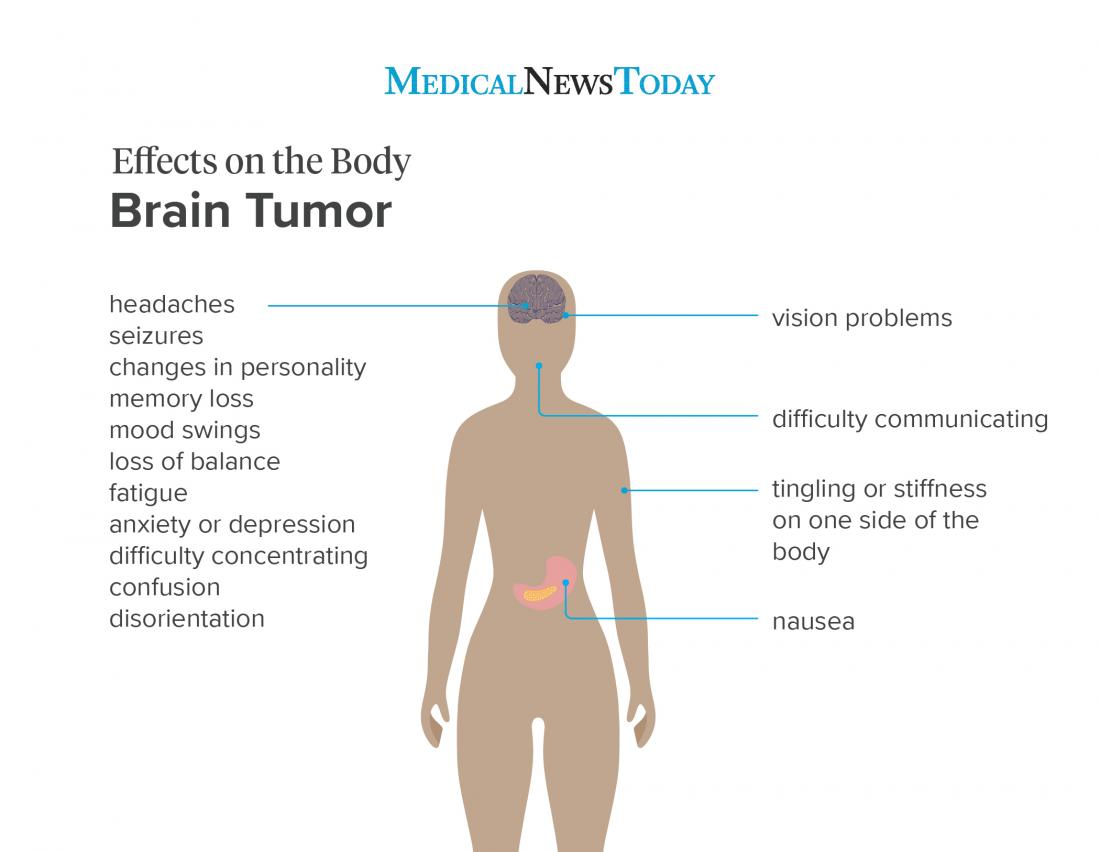Some symptoms can be quite general. These include headaches, vision problems, and mood changes. Seizures and personality changes can also signal the presence of a brain tumor.
If a person notices any early symptoms of a brain tumor, they should speak to their doctor for a thorough diagnosis. Early diagnosis and treatment can lead to better outcomes.
This article looks at various symptoms of brain tumors, including those linked to different types and locations of tumor, as well as the risk factors for each.
Symptoms

Brain tumor symptoms are similar regardless of whether they are cancerous (malignant) or noncancerous (benign).
They may differ depending on the type, location in the brain, and the stage of the tumor.
Some of the most common symptoms of a brain tumor include:
- headaches
- seizures
- changes in personality
- vision problems
- memory loss
- mood swings
- tingling or stiffness on one side of the body
- loss of balance
- nausea
- fatigue
- anxiety or depression
- difficulty concentrating
- difficulty communicating as usual
- feeling confused or disorientated
- loss of coordination
- muscle weakness
Primary brain tumors are tumors that begin in the brain.
In the sections below, we look at several types of brain tumor and their specific symptoms:
Meningioma
Roughly one-third of primary brain tumors are meningiomas. They are usually benign and slow growing.
They grow from tissue covering the brain and spinal cord and create pressure on these areas.
Meningiomas are rare in children and most common in women over the age of 60.
Symptoms of meningioma can include:
- headaches
- weakness in the arm or leg
- seizures
- changes in personality
- vision problems
Glioblastoma
Glioblastomas are malignant tumors. They can be fast growing and require more intensive treatment.
According to the American Brain Tumor Association, healthcare providers assign a grade to tumors depending on how abnormal the cells they contain are.
Grade 1 tumors are the least malignant and grade 4 are the most malignant. Glioblastomas are grade 4 tumors.
Glioblastomas create pressure on the brain, and symptoms include:
- nausea and vomiting
- headaches, which may be more intense in the morning
- weakness in the body, such as in an arm, a leg, or the face
- difficulty balancing
- problems with memory
- seizures
Astrocytoma

Headaches, memory loss, and seizures are all early symptoms of astrocytomas.
Astrocytomas are brain tumors that grow from cells called astrocytes, which make up brain tissue.
They can range from grade 1 to 4, with grade 1 tumors being slower growing than grade 4 tumors.
Some of the early symptoms for astrocytoma include:
- headaches
- memory loss
- seizures
- changes in behavior
Craniopharyngioma
A craniopharyngioma is a benign tumor that develops close to the pituitary gland. It is much more common in children than adults. Medulloblastoma and ependymomas are also more common among children.
The tumor creates pressure on the pituitary gland and optic tract, which is an extension of the optic nerve. This can cause the following symptoms:
- delay in development
- obesity
- vision problems due to a swollen optic nerve
- hormone problems
Pituitary tumors
Pituitary tumors develop in the pituitary gland and affect hormone levels. They tend to be more common in women and make up 9–12% of all primary brain tumors.
They are slow growing, though larger tumors can create pressure on surrounding areas of the brain. These tumors can secrete pituitary hormones and cause additional symptoms.
According to the American Cancer Society, tumors that start in the pituitary gland are almost always noncancerous.
Symptoms of pituitary tumors include:
- headaches
- vision problems
- changes in behavior
- changes in hormone levels
Metastatic
Metastatic brain tumors, or secondary brain tumors, form in other parts of the body where cancer is present and move to the brain through the bloodstream.
Metastatic brain tumors present the same symptoms as primary brain tumors, with the most common symptoms being:
- headaches
- seizures
- short term memory loss
- changes in personality or behavior
- weakness on one side of the body
- balance difficulties
Confusion conditions: Is it a brain tumor, migraine, or something else?
Symptoms of brain tumors can also be similar to those of other medical conditions, such as headaches and multiple sclerosis (MS).
Most headaches do not signal the presence of a brain tumor, and experiencing a headache by itself is usually not a cause for concern.
However, signs that a headache could be a symptom of a brain tumor include:
- persistent headaches, particularly if the person has no history of severe headaches
- headaches that increase in intensity over time
- headaches that are worse in the morning
- headaches that wake people up from sleep
Learn more about the possible causes of persistent headaches here.
If a person experiences frequent or severe headaches, they may have migraine, tension, or cluster headaches. These can also create feelings of nausea.
Symptoms of migraine can range from mild to severe and include:
- nausea, which may worsen with activity
- a throbbing sensation on one side of the head
- increased sensitivity to light and sound
- facial pain
A migraine headache can last anywhere from a few hours to a few days, or even weeks.
Read about the possible causes of headache with nausea here.
Tension headaches are usually mild to moderate, and symptoms include:
- headaches that build slowly
- dull pain on both sides of the head
- pain that can spread to the neck
Cluster headaches cause severe pain and occur in bursts. These episodes can last anywhere from 1 to 3 hours. Symptoms include:
- pain on one side of the head
- sudden pain around the eye area
- swelling or drooping of the eye
- feeling restless or agitated
- watery eyes and nasal congestion
- eye redness
MS is a condition that affects the central nervous system and can produce similar symptoms to those of a brain tumor. Some of the most common symptoms include:
- difficulty balancing
- fatigue
- mood swings
- depression
- numbness or tingling in the face, arms, or legs
- weakness in the body
- problems with vision
Less common symptoms include seizures, problems with speech, and hearing loss.
When to see a doctor

A person should see their doctor if they experience seizures, unexplained vision problems, or communication difficulties.
People should see their doctor if they experience any of the following symptoms:
- seizures
- weakness, numbness, or tingling in one side the body
- unexplained vision problems
- communication difficulties
- changes in personality or behavior
A doctor will take a full medical history and perform a range of neurological tests to see what is causing the symptoms. For example, they may:
- run CT scans or MRI scans, to provide an image of the brain
- conduct tests to check balance, vision, and coordination
Also, if they locate a tumor in the brain, they may take a tissue sample, or biopsy, to find out what type it is.
A person should see their doctor if they experience severe or frequent headaches. They will be able to rule out any underlying causes and suggest lifestyle changes or treatment options.
If a brain tumor is present, treatment will depend on the type and stage of the tumor. Options may include surgery, radiation therapy, or chemotherapy to remove or shrink the brain tumor.
Summary
People should see their doctor if they experience any of the symptoms listed above. Many of the symptoms overlap with those of other causes and may signal another health condition.
Tracking any symptoms can help a doctor determine a diagnosis. Keeping track of what time and how frequently symptoms occur can also help.
If a person does have symptoms that signal a brain tumor, early diagnosis and treatment are important to help prevent the tumor from growing.
